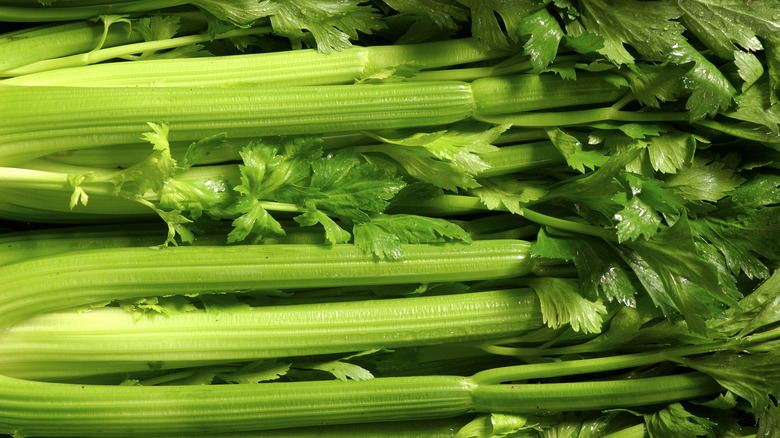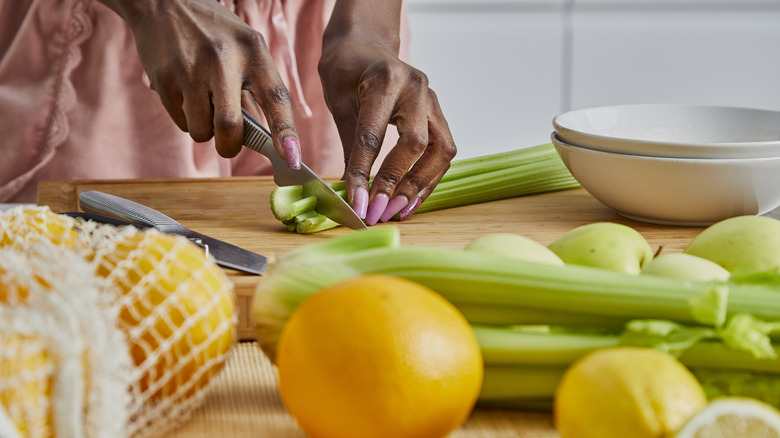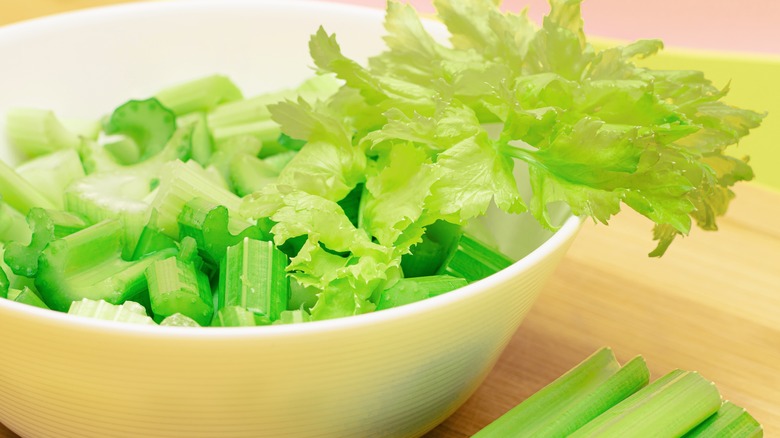The Best Way To Clean Celery So You Don't Have Those Annoying Strings
Could there be a vegetable more versatile than celery? It's not only the crispy backbone of crudité platters and essential to stir-fries, but it's also a vital ingredient in mirepoix (along with onions and carrots), which forms the basis for a wide range of dishes, from minestrone soup to Bolognese sauce.
Celery is also good for you, packed with vitamins, iron, and dietary fiber. What is not so good are the tough strings lining each stalk, just lying in wait to wedge in your teeth and ruin an otherwise tasty experience. These strings are known as collenchyma cells, and they are essentially water-filled structures of the plant that provide the snap, or crunch, that celery is known for. While harmless, they can make for an unpleasant mouthfeel.
Thankfully, there is a simple and effective way to remove these tough strings before digging into the veggie, and it's a trick that you can do at the same time that you are cleaning it. All that you need to get started is water and a paring knife. Note that while this technique can be done with a vegetable peeler too, a peeler may not cut deep enough into the rib to remove all the strings.
Cleaning and de-stringing your celery
To start, thoroughly wash your celery to remove any dirt, insects, or possible residue from pesticides. You can do this either by rinsing the stalks under cold running water, or by soaking them for a few minutes in a cold water bath. Both methods are effective, although if your celery is on the limp side, the water bath will have the added benefit of helping to restore and crisp up the veggie, returning it to its former glory.
Once the celery is clean, you can begin removing the strings. To do this, firmly grasp the stalk of celery in one hand, the paring knife in the other. Starting at one end, partially cut into the veggie with the knife. You should cut down into the open "U" of the stalk, slicing almost all the way through and stopping just prior to the thicker skin on the back. Grasping the cut end, slowly pull it down, so that the strings along the back all easily peel off.
You may have to repeat this process several times until all visible strings have been removed. Once done, flip the stalk and repeat on the other end, continuing to cut and pull until any remaining strings have been removed. This method is very straight-forward, and should take you less than 30 seconds per stalk.
Storage tips for celery
Whether you are adding celery to a healthy kale-based salad or a simple chicken soup, you'll want to start with the veggie in tip-top shape. Removing the strings is one way to achieve this, but you should also make sure that you store your celery properly to keep it fresh. Doing so will also help to prolong its life and keep the veggie super crispy.
The first thing you'll want to do when getting celery home is to remove it from the plastic bag that it likely came in. Plants such as celery produce the hormone ethylene, which helps to ripen the plant. But, plastic will seal in this hormone, causing the celery to ripen too quickly, and lead to rot.
A better solution is to wrap the stalks in aluminum foil. The foil helps to retain moisture while still allowing the veggie to "breathe," so your celery can stay crisp for up to two weeks. Storing celery in the crisper drawer of your refrigerator is also a great way to keep it fresher for longer.



